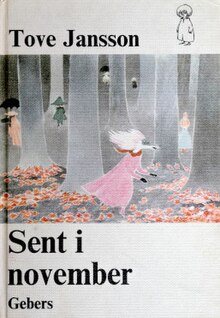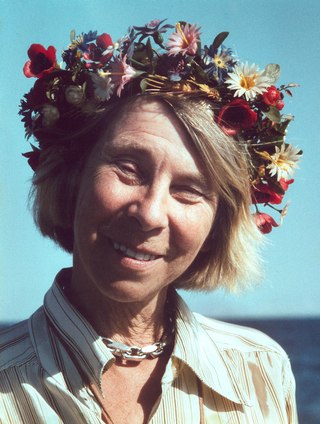
Tove Marika Jansson was a Swedish-speaking Finnish author, novelist, painter, illustrator and comic strip author. Brought up by artistic parents, Jansson studied art from 1930 to 1938 in Helsinki, Stockholm, and Paris. She held her first solo art exhibition in 1943. Over the same period, she penned short stories and articles for publication, and subsequently drew illustrations for book covers, advertisements, and postcards. She continued her work as an artist and writer for the rest of her life.

Snufkin is a character in the Moomin series of books written by Swedish-speaking Finn Tove Jansson, appearing in six of the nine books; his first appearance is in the second book, Comet in Moominland. He is the best friend of the series' protagonist, Moomintroll, and lives a nomadic lifestyle, only staying in Moominvalley in the spring and summer, but leaving for warmer climates down south every winter. He is the son of the elder Mymble and the Joxter, and is half-brother to the Mymble's daughter and Little My.

Little My is a character in the Moomin series of books by Tove Jansson. The character first appeared in the fourth book, The Exploits of Moominpappa (1950). She is a small, determined and fiercely independent Mymble. Little My is brash, aggressive, mischievous and disrespectful, but can also be a good friend when she wants to. She is the Mymble's daughter's younger sister. She was eventually adopted by the Moomin family.

Moomin World is a theme park based on the Moomin books by Tove Jansson. It was designed by Dennis Livson, and is located on the island of Kailo next to the old town of Naantali, in Southwest Finland.

Comet in Moominland is the second in Finnish author Tove Jansson's series of Moomin books. Published in 1946, it marks the first appearance of several main characters, such as Snufkin and the Snork Maiden.

Moominsummer Madness is the fifth in the series of Tove Jansson's Moomins books, published in 1954.

Moominland Midwinter is the sixth in the series of Tove Jansson's Moomin books, published in 1957. This book sees Jansson adopt a darker, more introspective tone compared to the earlier books that is continued in the remainder of the series. Often in the book Moomintroll is either lonely, miserable, angry or scared - the result of being forced to survive in a world to which he feels he does not belong. While preserving the charm of the previous novels, the story involves a more in-depth exploration of Moomintroll's character than before.
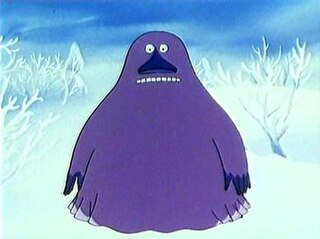
The Groke is a fictional character in the Moomin stories created by Tove Jansson. She appears as a ghost-like, hill-shaped body with two cold staring eyes and a wide row of white shiny teeth. In the book Who Will Comfort Toffle?, it is mentioned that she has a tail, but it has never been seen. Wherever she stands, the ground below her freezes and plants and grass die. She leaves a trace of ice and snow when she walks the ground. Anything that she touches will freeze. On one occasion, she froze a campfire by sitting down on it. She seeks friendship and warmth, but she is declined by everyone and everything, leaving her in her cold cavern on top of the Lonely Mountains.
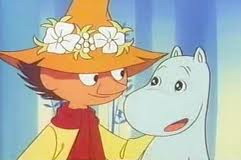
New Moomin is a Japanese anime television series produced by Zuiyo Enterprise and animated by Mushi Production. The series is a sequel series to the series Moomin, which aired from 1969 to 1970, and is based largely on the Moomin books by Tove Jansson. It was produced in 1972 as part of the Calpis Comic Theater and broadcast on Fuji TV.

Moomin is a Japanese anime television series produced by Zuiyo Enterprise and animated by Tokyo Movie until episode 26 and by Mushi Production after episode 27. The series is loosely based on the Moomin books by the Finnish author Tove Jansson and was broadcast on Fuji Television from 1969 to 1970. A sequel series entitled Shin Muumin was later released in 1972.
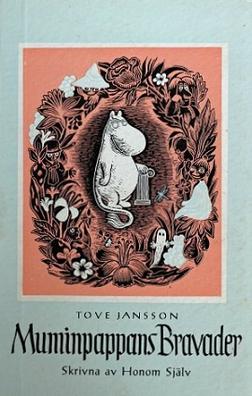
The Exploits of Moominpappa, first published in 1950 and then considerably revised in 1968 under the title Moominpappa's Memoirs, is the fourth book in the Moomin series by Tove Jansson. The story found in this book is mentioned in the previous Moomin books, as Moominpappa writes his memoirs in those stories. Unlike Comet in Moominland and Finn Family Moomintroll, both versions of the novel were translated into English. Exploits of Moominpappa forms the basis of episodes 62, 63 and 64 in the 1990 TV series.

Tales from Moominvalley is the seventh book in the Moomins series by Finnish author Tove Jansson. Unlike all the other books, which were novels, it is a collection of short stories, the longest book in the series. It was first published in 1962. The book forms the basis of episodes 9, 10, 13, 24, and 36 of the 1990 series.
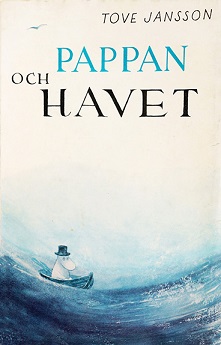
Moominpappa at Sea is the eighth book in the Moomin books by Finnish author Tove Jansson. First published in 1965, the novel is set contemporaneously with Moominvalley in November (1970), and is the final installment in the series where the titular Moomin family are present within the narrative.

The Book about Moomin, Mymble and Little My was the first Moomin picture book by Finnish author Tove Jansson, published in 1952 in Swedish. It is the first Moomin book to be adapted into an iPad app.

The Moomins are the central characters in a series of novels, short stories, picture books, and a comic strip by Finnish writer and illustrator Tove Jansson, originally published in Swedish by Schildts in Finland. They are a family of white, round fairy-tale characters with large snouts that make them resemble the hippopotamus. However, despite this resemblance, the Moomin family are trolls. The family live in their house in Moominvalley.

Moomins and the Comet Chase is a 2010 3D stop motion animated fantasy adventure comedy family film compiled from the Comet in Moominland-based episodes of the 1977–1982 The Moomins TV series animated at Se-ma-for in Poland, restored and re-soundtracked with multiple voice actors replacing the single narrator. It is the second such Moomin film produced by Finnish children's film company Filmkompaniet, the first being Moomin and Midsummer Madness, and the first one converted to stereoscopic 3-D. A similar revision of the remainder of the series for high-definition television of all 78 episodes will follow and is currently in production. The same novel has been adapted into film at least twice before, with the 1978 Russian stop motion serial Mumi-troll and the 1992 Japanese traditional animation feature Comet in Moominland. The international version of the film features the voices of known Swedish actors like Stellan Skarsgård, Peter Stormare, Alexander Skarsgård. Musician and Moomins fan Björk also wrote an original song for the film. The international film debuted at the Cannes Film Festival in May 2010. In Finland, it arrived in movie theaters on 6 August 2010 and was later broadcast on the MTV3 channel. The film was also produced in dozens of other languages and subsequently received global distribution.
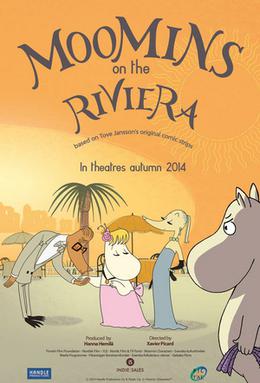
Moomins on the Riviera is a 2014 Finnish-French animated family comedy film directed by Xavier Picard and produced by Hanna Hemilä, who is also co-director. The film is based on Moomin comic strips by Tove Jansson and Lars Jansson.

Moomin is a Dutch-Japanese-Finnish anime television series produced by Telecable Benelux B.V. and animated by Telescreen Japan. Based on the Moomin novels and comic strips by the Finnish illustrator and author Tove Jansson and her brother Lars Jansson, it was the third anime adaptation of the property and the first to receive distribution in different countries worldwide. Moomin first aired on TV Tokyo from April 12, 1990, to October 3, 1991. The series had also been dubbed into English and aired on CBBC in United Kingdom during the same year.
Metsä is a Nordic-themed entertainment complex in Hannō, Saitama Prefecture, Japan. The complex consists of Metsä Village, entertainment and leisure area which opened in November 2018, and Moominvalley Park, which opened in 2019. The park was initially planned to start operation in 2015 to mark the 100th birthday of Tove Jansson. On June 30, 2015, it was announced that the opening would be delayed until 2017 at the earliest. On December 6, 2016, the opening date was further delayed to spring 2019.
